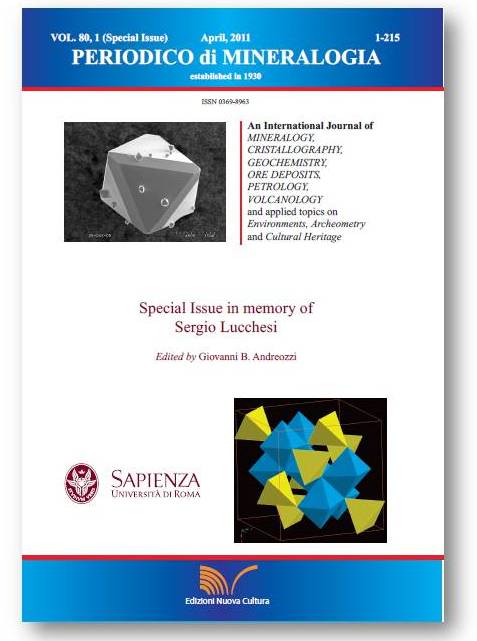The inverse high temperature/high pressure relationship in the monoclinic Ba<sub>2</sub>MgSi<sub>2</sub>O<sub>7</sub> melilite-related structure
DOI:
https://doi.org/10.2451/2011PM0013Keywords:
melilite-related structures, melilite-type structures, inverse relationship, high-temperature, high-pressure, comparative crystal chemistry.Abstract
Periodico di Mineralogia (2011), 80, 1 (Special Issue), 155-16 - DOI: 10.2451/2011PM0013
Special Issue in memory of Sergio Lucchesi
The inverse high temperature/high pressure relationship in the monoclinic Ba2MgSi2O7 melilite-related structure
Matteo Ardit1, Chiara Zanelli2, Michele Dondi2, and Giuseppe Cruciani1,*
1Dipartimento di Scienze della Terra, Università di Ferrara, Italy
2Istituto di Scienza e Tecnologia dei Materiali Ceramici (ISTEC - CNR), Faenza, Italy
*Corresponding author: cru@unife.it
Abstract
High-temperature study of the synthetic melilite-related Ba2MgSi2O7 (s.g. C2/c) was performed up to 1273 K. Linear thermal expansion coefficients along the unit cell edges and of the volume are αa = 8.7×10-6 K-1, αb = 11.0×10-6 K-1, αc = 8.5×10-6 K-1, and αV = 31.1×10-6 K-1, respectively, showing an anisotropic expansion behaviour characterized by αa ≈ αc < αb. High-temperature data were then combined with high-pressure data (taken from the literature) for the same monoclinic sample. The "inverse relationship" of variation against temperature and pressure is observed for both the unit cell parameters and the (c/a) axial ratio as a function of the molar volume. A further comparison with melilite-type compounds at ambient condition along the join (Ca-Sr-Ba)2MgSi2/sub>O7 reveals that the tetragonal polymorph of the barium compound (Ba2MgSi2O7) should be a metastable phase favoured by high pressure conditions.
Key words: melilite-related structures; melilite-type structures; “inverse relationship”; high-temperature; high-pressure; comparative crystal chemistry.


